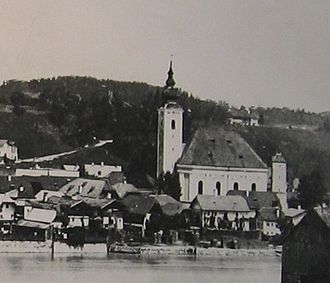
"And there were shepherds living out in the fields nearby, keeping watch over their flocks at night" — Luke 2:8
While Barbara and I were serving as missionaries in Europe, we visited the small Silent Night Chapel near Salzburg, Austria. An older church building not far away was the actual birthplace of "Silent Night." Floods destroyed that building in the 1890s. Here's the story of how this most famous Christmas carol came to be written:
In 1818, a roving band of actors was performing in towns throughout the Austrian Alps. On December 23, they arrived at Oberndorf, a village near Salzburg, where they were to re-enact the story of Christ's birth in the small Church of St. Nicholas.
Unfortunately, the St. Nicholas' church organ wasn't working and would not be repaired before Christmas. (Note: Some versions of the story point to mice as the problem; others say rust was the culprit.) Because the church organ was out of commission, the actors presented their Christmas drama in a private home. That Christmas presentation of the events in the first chapters of Matthew and Luke put assistant pastor Josef Mohr in a meditative mood. Instead of walking straight home that night, Mohr took a longer way to his house. The longer path took him up on a hill overlooking the village.
From that hilltop, Mohr looked down on the peaceful snow-covered village. Reveling in the majestic silence of a wintry night, he recalled a poem he had written a couple of years before about the night angels announced the birth of the Messiah to shepherds.

Mohr decided those words might make a good carol for his congregation the following evening at their Christmas Eve service. The problem was he didn't have any music to which that poem could be sung. So, the next day, Mohr went to see the church organist, Franz Xaver Gruber. Gruber only had a few hours to compose a melody that could be played on a guitar. By that evening, Gruber had composed a musical setting for the poem. That the church organ was inoperable no longer mattered. They now had a Christmas carol that could be sung without an organ.
On Christmas Eve, the small Oberndorf congregation heard Gruber and Mohr sing their new composition to the accompaniment of Gruber's guitar.
Weeks later, well-known organ builder Karl Mauracher arrived in Oberndorf to fix the organ in St. Nicholas church. When Mauracher finished, he let Gruber test the instrument. Gruber began playing the simple melody he had written for Mohr's poem. Impressed, Mauracher took copies of the music and words back to his own Alpine village, Kapfing. There, two well-known families of singers — the Rainers and the Strassers — heard it. Captivated by "Silent Night," both groups put the new song into their Christmas repertoire.
Silent night! holy night!
All is calm, all is bright,
'Round yon virgin mother and Child!
Holy Infant, so tender and mild,
Sleep in heavenly peace,
Sleep in heavenly peace.
The Strasser sisters spread the carol across northern Europe. In 1834, they performed "Silent Night" for King Frederick William IV of Prussia, who liked it so much he ordered his cathedral choir to sing it every Christmas Eve.
Twenty years after "Silent Night" was written, the Rainers brought the song to the United States, singing the original German version at New York City's Trinity Church.
In 1863, nearly fifty years after being sung in German, "Silent Night" was translated into English by either Jane Campbell or John Young. Eight years later, that English version made its way into print in Charles Hutchins' Sunday School Hymnal. Today, the words of "Silent Night" are sung worldwide in more than 300 languages.
Artists who have recorded it in English include Bing Crosby, Elvis Presley, and Mariah Carey. Bing Crosby's version is one of the best-selling singles of all time.

Image sources: Silent Night Chapel - Wikipedia and Stille Nacht Manufaktur.
"The time came for the baby to be born, and [Mary] gave birth to her firstborn, a son. She wrapped him in cloths and placed him in a manger." — Luke 2:6-7
![]() See a copy of
German words written by Mohr and the tune written by Gruber.
The original manuscript of "Silent Night," long thought to be lost, was rediscovered in 1995.
See a copy of
German words written by Mohr and the tune written by Gruber.
The original manuscript of "Silent Night," long thought to be lost, was rediscovered in 1995.
![]() Words to "Silent Night" in more than 100 languages:
click here.
Words to "Silent Night" in more than 100 languages:
click here.
During World War I, on Christmas Eve in 1914, soldiers on both sides of the Western Front sang "Silent Night" in their respective languages, leading to an impromptu ceasefire known as the Christmas Truce. The shared carol affirmed the common humanity of the soldiers despite the conflict.
In 2011, "Silent Night" was declared an intangible cultural heritage by UNESCO, recognizing the song's cultural significance and lasting popularity.
Dave Hartley and Keith White playing "Silent Night" on pedal steel guitars
![]() Each year on December 24th at 5 pm Central European Time (11 a.m. CST in the USA), the city of Oberndorf honors Franz Xaver Gruber and Joseph Mohr with a celebration broadcast live by
webcam.
Each year on December 24th at 5 pm Central European Time (11 a.m. CST in the USA), the city of Oberndorf honors Franz Xaver Gruber and Joseph Mohr with a celebration broadcast live by
webcam.
|
|
Are we more interested in His presents than in His presence? [ more ] |
-- Howard Culbertson, hculbert@snu.edu